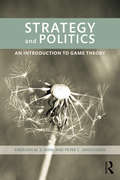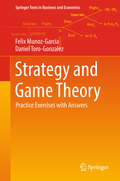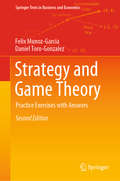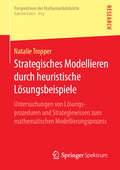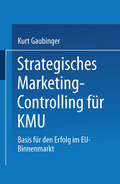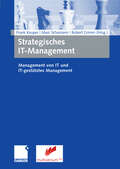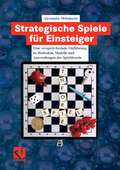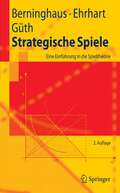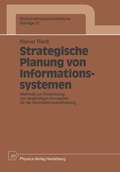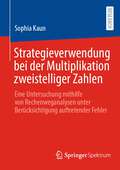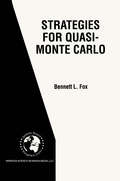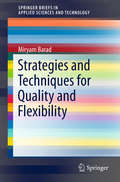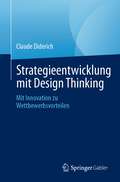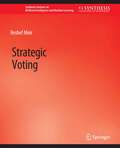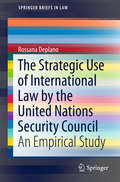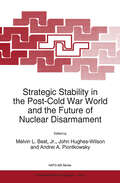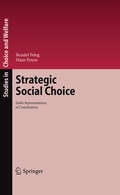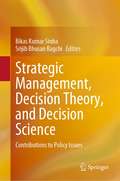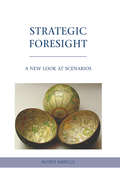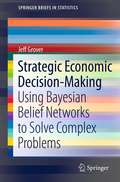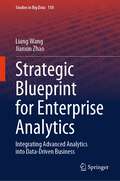- Table View
- List View
Strategy and Politics: An Introduction to Game Theory
by Emerson Niou Peter C. OrdeshookStrategy and Politics: An Introduction to Game Theory is designed to introduce students with no background in formal theory to the application of game theory to modeling political processes. This accessible text covers the essential aspects of game theory while keeping the reader constantly in touch with why political science as a whole would benefit from considering this method. Examining the very phenomena that power political machineries—elections, legislative and committee processes, and international conflict, the book attempts to answer fundamental questions about their nature and function in a clear, accessible manner. Included at the end of each chapter is a set of exercises designed to allow students to practice the construction and analysis of political models. Although the text assumes only an elementary-level training in algebra, students who complete a course around this text will be equipped to read nearly all of the professional literature that makes use of game theoretic analysis.
Strategy and Politics: An Introduction to Game Theory
by Emerson Niou Peter C. OrdeshookStrategy and Politics: An Introduction to Game Theory is designed to introduce students with no background in formal theory to the application of game theory to modeling political processes. This accessible text covers the essential aspects of game theory while keeping the reader constantly in touch with why political science as a whole would benefit from considering this method. Examining the very phenomena that power political machineries—elections, legislative and committee processes, and international conflict, the book attempts to answer fundamental questions about their nature and function in a clear, accessible manner. Included at the end of each chapter is a set of exercises designed to allow students to practice the construction and analysis of political models. Although the text assumes only an elementary-level training in algebra, students who complete a course around this text will be equipped to read nearly all of the professional literature that makes use of game theoretic analysis.
Strategy and Game Theory: Practice Exercises with Answers (Springer Texts in Business and Economics)
by Felix Munoz-Garcia Daniel Toro-GonzalezThis textbook presents worked-out exercises on game theory with detailed step-by-step explanations. While most textbooks on game theory focus on theoretical results, this book focuses on providing practical examples in which students can learn to systematically apply theoretical solution concepts to different fields of economics and business. The text initially presents games that are required in most courses at the undergraduate level and gradually advances to more challenging games appropriate for masters level courses. The first six chapters cover complete-information games, separately analyzing simultaneous-move and sequential-move games, with applications in industrial economics, law, and regulation. Subsequent chapters dedicate special attention to incomplete information games, such as signaling games, cheap talk games, and equilibrium refinements, emphasizing common steps and including graphical illustrations to focus students’ attention on the most relevant payoff comparisons at each point of the analysis. In addition, exercises are ranked according to their difficulty, with a letter (A-C) next to the exercise number. This allows students to pace their studies and instructors to structure their classes accordingly. By providing detailed worked-out examples, this text gives students at various levels the tools they need to apply the tenets of game theory in many fields of business and economics. This text is appropriate for introductory-to-intermediate courses in game theory at the upper undergraduate and master’s level.
Strategy and Game Theory: Practice Exercises with Answers (Springer Texts in Business and Economics)
by Felix Munoz-Garcia Daniel Toro-GonzalezThis textbook presents worked-out exercises on game theory with detailed step-by-step explanations. While most textbooks on game theory focus on theoretical results, this book focuses on providing practical examples in which students can learn to systematically apply theoretical solution concepts to different fields of economics and business. The text initially presents games that are required in most courses at the undergraduate level and gradually advances to more challenging games appropriate for graduate level courses. The first six chapters cover complete-information games, separately analyzing simultaneous-move and sequential-move games, with applications in industrial economics, law, and regulation. Subsequent chapters dedicate special attention to incomplete information games, such as signaling games, cheap talk games, and equilibrium refinements, emphasizing common steps and including graphical illustrations to focus students’ attention on the most relevant payoff comparisons at each point of the analysis. In addition, exercises are ranked according to their difficulty, with a letter (A-C) next to the exercise number. This allows students to pace their studies and instructors to structure their classes accordingly. By providing detailed worked-out examples, this text gives students at various levels the tools they need to apply the tenets of game theory in many fields of business and economics. The second edition of the text has been revised to provide additional exercises at the introductory and intermediate level, expanding the scope of the book to be appropriate for upper undergraduate students looking to improve their understanding of the subject. The second edition also includes a new chapter devoted entirely to cheap talk games. Revised to appeal to a larger audience of instructors and students, this text is appropriate for introductory-to-intermediate courses in game theory at the upper undergraduate and graduate levels.
Strategisches Modellieren durch heuristische Lösungsbeispiele: Untersuchungen von Lösungsprozeduren und Strategiewissen zum mathematischen Modellierungsprozess (Perspektiven der Mathematikdidaktik)
by Natalie TropperDie Vermittlung mathematischer Modellierungskompetenz stellt ein zentrales Ziel kompetenzorientierten Mathematikunterrichts dar. Da bislang nur vereinzelt spezifische Vermittlungsaspekte zur Förderung dieser Kompetenz untersucht wurden, geht Natalie Tropper dieser Thematik im Rahmen einer qualitativ angelegten Untersuchung nach. Sie betrachtet die Einflüsse strategiebetonter heuristischer Lösungsbeispiele auf die Modellierungsprozesse und das modellierungsbezogene Strategiewissen von Schülerinnen und Schülern. Die Ergebnisse ihrer empirischen Studie zeigen das Potential des gewählten Instruktionsmaterials zur Unterstützung modellierungsbezogener Lernprozesse auf und legen zugleich Implikationen für dessen unterrichtliche Einbettung nahe.
Strategisches Marketing-Controlling für KMU: Basis für den Erfolg im EU-Binnenmarkt (Gabler Edition Wissenschaft)
by Kurt GaubingerAuf der Basis einer in Österreich durchgeführten qualitativen Feldstudie entwickelt Kurt Gaubinger ein System zum strategischen Marketing-Controlling, das auf die Anforderungen mittelständischer Fertigungsbetriebe abgestimmt ist.
Strategisches IT-Management: Management von IT und IT-gestütztes Management
by Frank Keuper Marc Schomann Robert GrimmRenommierte Autoren beleuchten die Schnittstellen zwischen IT, IT-Management und strategischem Management aus zwei Perspektiven. Zum einen diskutieren sie moderne Konzepte, Ansätze und Strategien des "Strategischen IT-Management", zum anderen die Möglichkeiten und Grenzen eines IT-gestützten strategischen (internationalen) Management.
Strategische Spiele für Einsteiger: Eine verspielt-formale Einführung in Methoden, Modelle und Anwendungen der Spieltheorie
by Alexander MehlmannIm Spannungsfeld von Philosophie, Politologie, Literatur, Ökonomie und Biologie hat sich die Spieltheorie zu einem der erfolgreichsten Werkzeuge der Mathematik entwickelt. Die "Strategischen Spiele für Einsteiger" zeichnen in beispielhaften Mustern das breite Anwendungsspektrum der Theorie interaktiver Entscheidungen nach. Ein unterhaltsamer Einstieg in die Spieltheorie, der sowohl den mathematischen Grundlagen wie auch den kulturellen Aspekten strategischer Konfliktsituationen Tribut zollt. Ein eigener Abschnitt ist den in herkömmlichen Lehrbüchern eher stiefmütterlich behandelten Differentialspielen gewidmet.
Strategische Spiele: Eine Einführung in die Spieltheorie (Springer-Lehrbuch)
by Siegfried K. Berninghaus Karl-Martin Ehrhart Werner GüthEinführender Text in die nicht-kooperative Spieltheorie, der besonders für Studenten geeignet ist, die Freude an präziser Modellierung haben. Neben den Grundlagen der Normalform- und Extensivformspiele werden Themen aus der Verhandlungstheorie, der Theorie der Wiederholten Spiele und der Evolutionären Spieltheorie behandelt. NEU: entsprechend der wachsenden Bedeutung von Auktionen ein Kapitel zur Auktionstheorie; Aufnahme weiterer Konzepte der nicht-kooperativen Spieltheorie wie z. B. "Mechanism Design" und "Stabiles Gleichgewicht".
Strategische Planung von Informationssystemen: Methode zur Entwicklung von langfristigen Konzepten für die Informationsverarbeitung (Wirtschaftswissenschaftliche Beiträge #51)
by Rainer RiedlDie vorliegende Arbeit wendet sich ebenso an Studenten und Wissenschaftler, die sich mit methodischen Problemen der strategischen Informationssystemplanung beschäftigen, wie an EDV-Berater bzw. Praktiker, die sich über den Stand der Technik in diesem Bereich informieren wollen. Zunächst wird ein Überblick über Stärken und Schwächen der wesentlichen Ansätze zur strategischen Planung von betrieblichen Informationssystemen gegeben. Anhand der diagnostizierten methodischen Schwächen wird die Notwendigkeit für eine Integration bzw. Erweiterung des vorhandenen Instrumentariums für die strategische Informationssystemplanung abgeleitet. Im Anschluß daran präsentiert der Autor seine Vorschläge zur Entwicklung von strategischen Langfristkonzepten für die Informationsverarbeitung in Organisationen, bei denen vor allem auf die ganzheitliche Darstellung der Vorgehensweise geachtet wurde. Im Vordergrund stehen dabei Konzepte für die Daten-, Applikations- und Kommunikationsstrukturen, für die Ressourcen sowie für die Organisation und Führung des Bereichs Informationsverarbeitung. Neben den rein methodischen Empfehlungen unterbreitet der Autor auch detaillierte Vorschläge für die Abwicklung derartiger Planungsprojekte und erläutert die Einsatzbedingungen seiner Methode. Schließlich werden rechnerbasierte Werkzeuge zur Unterstützung der strategischen Informationssystemplanung diskutiert.
Strategische Analyse der sekundären Hypertonieprävention: Entwurf mathematisch-medizinökonomischer Modelle auf empirischer Basis (Medizinische Informatik, Biometrie und Epidemiologie #46)
by K. HeidenbergerStrategieverwendung bei der Multiplikation zweistelliger Zahlen: Eine Untersuchung mithilfe von Rechenweganalysen unter Berücksichtigung auftretender Fehler
by Sophia KaunDas Verstehen und Beherrschen der Multiplikation gehört zu den zentralen Kompetenzen, die Schüler und Schülerinnen am Ende der Grundschule erreicht haben sollen. In dieser Arbeit wird eine empirische Studie vorgestellt, die Lösungswege bei der Multiplikation zweistelliger Zahlen erfasst und die Strategieverwendung unter Berücksichtigung auftretender Fehler untersucht. Vor diesem Hintergrund wurden Rechenstrategien und Fehler bei der Bearbeitung von Multiplikationsaufgaben zweistelliger Zahlen umfassend kategorisiert und ausgewertet. Dafür wurden etwa 10.000 Lösungswege von 2000 Kindern zu Beginn der 5. Jahrgangstufe mittels einer schriftlichen Befragung erhoben.
Strategies for Quasi-Monte Carlo (International Series in Operations Research & Management Science #22)
by Bennett L. FoxStrategies for Quasi-Monte Carlo builds a framework to design and analyze strategies for randomized quasi-Monte Carlo (RQMC). One key to efficient simulation using RQMC is to structure problems to reveal a small set of important variables, their number being the effective dimension, while the other variables collectively are relatively insignificant. Another is smoothing. The book provides many illustrations of both keys, in particular for problems involving Poisson processes or Gaussian processes. RQMC beats grids by a huge margin. With low effective dimension, RQMC is an order-of-magnitude more efficient than standard Monte Carlo. With, in addition, certain smoothness - perhaps induced - RQMC is an order-of-magnitude more efficient than deterministic QMC. Unlike the latter, RQMC permits error estimation via the central limit theorem. For random-dimensional problems, such as occur with discrete-event simulation, RQMC gets judiciously combined with standard Monte Carlo to keep memory requirements bounded. This monograph has been designed to appeal to a diverse audience, including those with applications in queueing, operations research, computational finance, mathematical programming, partial differential equations (both deterministic and stochastic), and particle transport, as well as to probabilists and statisticians wanting to know how to apply effectively a powerful tool, and to those interested in numerical integration or optimization in their own right. It recognizes that the heart of practical application is algorithms, so pseudocodes appear throughout the book. While not primarily a textbook, it is suitable as a supplementary text for certain graduate courses. As a reference, it belongs on the shelf of everyone with a serious interest in improving simulation efficiency. Moreover, it will be a valuable reference to all those individuals interested in improving simulation efficiency with more than incremental increases.
Strategies and Techniques for Quality and Flexibility (SpringerBriefs in Applied Sciences and Technology)
by Miryam BaradThis book presents strategic perspectives on quality and flexibility, as well as quantitative tools for assessing their implementation in a range of systems. It introduces readers to the global changes in the relative importance of quality strategies and flexibility strategies over the past 30 to 40 years. In addition, it presents detailed examples of how multi-purpose techniques such as design of experiments, petri nets and quality function deployment can be applied to evaluate quality and flexibility in the design, planning and operation of various systems. Uniquely, the book combines strategies and quantitative research tools in a single volume. It also includes many examples that are accessible to readers from different disciplines, and familiarizes readers with techniques that can facilitate their current and future research – making it a valuable resource for researchers, practitioners and advanced students alike.
Strategieentwicklung mit Design Thinking: Mit Innovation zu Wettbewerbsvorteilen
by Claude DiderichIn diesem Buch wird die Anwendung der Design-Thinking-Methode zur Entwicklung von neuartigen Strategien und neuer Geschäftsideen dargestellt. Neue Strategien sind nötig, da die wirtschaftlichen Rahmenbedingungen sich in den letzten Jahren schneller verändert haben als jemals zuvor. Der Fokus liegt auf dem Erfüllen von Kundenbedürfnissen, dem Einsatz von verfügbaren Fähigkeiten und der Positionierung im Wettbewerb mit dem Ziel, finanziell erfolgreich zu sein.Der Autor führt den Leser durch den Dschungel der Entwicklung einer Strategie für nachhaltiges Wachstum und Rentabilität. Er behandelt das Thema Strategieentwicklung auf ganzheitliche Art und Weise, indem er abduktives Denken, iterative Kundenbeobachtung und Empathie mit der Entwicklung von Ideen und Validierung von Prototypen durch Kunden kombiniert.Dieses Buch wendet die Design-Thinking-Methode zur Strategieentwicklung auf einzigartige Weise an. Es ist ein Muss für Hochschulabsolventen, MBAs und Führungskräfte, die sich für Innovation und Strategie interessieren, sowie für Strategen, Innovationsmanager, Analysten und Unternehmensberater.Aus dem InhaltKonzepte und Theorien zur innovativen StrategieentwicklungEin strukturierter Ansatz zur StrategieentwicklungSchaffung der Grundlagen für eine erfolgreiche StrategieIterative Entwicklung des der Strategie zugrunde liegenden GeschäftsmodellsDie entworfene Strategie dem Wettbewerbsumfeld aussetzen
Strategic Voting (Synthesis Lectures on Artificial Intelligence and Machine Learning)
by Reshef LiuSocial choice theory deals with aggregating the preferences of multiple individuals regarding several available alternatives, a situation colloquially known as voting. There are many different voting rules in use and even more in the literature, owing to the various considerations such an aggregation method should take into account. The analysis of voting scenarios becomes particularly challenging in the presence of strategic voters, that is, voters that misreport their true preferences in an attempt to obtain a more favorable outcome. In a world that is tightly connected by the Internet, where multiple groups with complex incentives make frequent joint decisions, the interest in strategic voting exceeds the scope of political science and is a focus of research in economics, game theory, sociology, mathematics, and computer science. The book has two parts. The first part asks "are there voting rules that are truthful?" in the sense that all voters have an incentive to report their true preferences. The seminal Gibbard-Satterthwaite theorem excludes the existence of such voting rules under certain requirements. From this starting point, we survey both extensions of the theorem and various conditions under which truthful voting is made possible (such as restricted preference domains). We also explore the connections with other problems of mechanism design such as locating a facility that serves multiple users. In the second part, we ask "what would be the outcome when voters do vote strategically?" rather than trying to prevent such behavior. We overview various game-theoretic models and equilibrium concepts from the literature, demonstrate how they apply to voting games, and discuss their implications on social welfare.We conclude with a brief survey of empirical and experimental findings that could play a key role in future development of game theoretic voting models.
The Strategic Use of International Law by the United Nations Security Council: An Empirical Study (SpringerBriefs in Law)
by Rossana DeplanoThe book offers insights on whether international law can shape the politics of the Security Council and conversely, the extent to which the latter contribute to the development of international law. By providing a systematic analysis of the quantity and quality of international legal instruments referred to in the text of resolutions, the book reconstructs patterns of the Security Council’s behavioural regularities and assesses them against the provisions of the United Nations Charter, which establishes its mandate. The analysis is divided into three periods – the origins and Cold War period, post-Cold War period and the twenty-first century – and assesses the resolutions passed in each period by thematic category. The book argues that while international law plays an important role in shaping the politics of the Security Council, the Council’s resolutions do not contribute significantly to the development of international law.
Strategic Trading in Illiquid Markets (Lecture Notes in Economics and Mathematical Systems #553)
by Burkart MönchThe Area of Research and the Object of Investigation In this thesis we will investigate trading strategies in illiquid markets from a market microstructure perspective. Market microstructure is the academic term for the branch of financial economics that investigates trading and the organization of security markets, see, e. g. , Harris (2002). Historically, exchanges evolved as a location, where those interested in buy ing or selling securities could meet physically to transact. Thus, traditionally security trading was organized on exchange floors, where so-called dealers arranged all trades and provided liquidity by quoting prices at which they were willing buy or sell. Consequently, the initial surge of the market mi crostructure literature focused predominantly on this type of market design, which is often referred to as quote-driven. Nowadays, the interest is shifting towards order-driven markets. Beginning with the Toronto Stock Exchange in the mid 1970s and increasing in fre quency and scope, this market structure has emerged as the preeminent form of security trading worldwide. In order-driven markets, exchanges arrange trades by matching public orders, often by employing automatic execution systems. Introduction A major difference between a quote-driven and an order-driven market arises from the transparency pre- and post-trade. The pre-trade transparency con cerns the question whether the order book is visible to the keeper only, or whether it is open to the public.
Strategic Stability in the Post-Cold War World and the Future of Nuclear Disarmament (NATO Science Partnership Subseries: 1 #3)
by Melvin L. BestThis Report contains a Consensus Report and the papers submitted to the April 6 -10, 1995 NATO Advanced Research Workshop on Strategic Stability In The Post-Cold War World And The Future Of Nuclear Disarmament, held in Washington D. C. , United States Of America of at The Airlie Conference Center. The workshop was sponsored by the NATO Division Scientific and Environmental Affairs as part of its ongoing outreach programme to widen and deepen scientific contacts between NATO member countries and the Cooperation Partner countries of the former Warsaw Treaty Organization. The participants recognize that the collapse of the former Soviet Union has left a conceptual vacuum in the definition of a new world order. Never before have the components of world order all changed so rapidly, so deeply, or so globally. As Henry Kissinger points out, the emergence of the new world order will have answered three fundamental questions:" What are the basic units of the international order? What are their means of interacting? and What are the goals on behalf of which they interact? " The main question is whether the establishment and maintenance of an international system will turn out to be a conscious design, or the outgrowth of a test of strength. The concept of a planning framework that could shape or govern these interactions is emerging and may now be at hand. Capturing this emerging framework is the thrust of this NATO-sponsored Advanced Research Workshop.
Strategic Social Choice: Stable Representations of Constitutions (Studies in Choice and Welfare)
by Bezalel Peleg Hans PetersThis book was written mainly during the Spring periods of 2008 and 2009, when the ?rst author was visiting Maastricht University. Financial s- port both from the Dutch Science Foundation NWO (grants 040. 11. 013 and 0. 40. 11. 082) and from the research institute METEOR (Maastricht Univ- sity) is gratefully acknowledged. Jerusalem Bezalel Peleg Maastricht Hans Peters April 2010 v Contents Preview to this book . . . . . . . . . . . . . . . . . . . . . . . . . . . . . . . . . . . . . . . . . xi Part I Representations of constitutions 1 Introduction to Part I. . . . . . . . . . . . . . . . . . . . . . . . . . . . . . . . . . . . 3 1. 1 Motivation and summary. . . . . . . . . . . . . . . . . . . . . . . . . . . . . . . . 3 1. 2 Arrow’s constitution. . . . . . . . . . . . . . . . . . . . . . . . . . . . . . . . . . . . 3 1. 3 Arrow’s Impossibility Theorem and its implications. . . . . . . . . 4 1. 4 Ga ¨rdenfors’s model. . . . . . . . . . . . . . . . . . . . . . . . . . . . . . . . . . . . . 5 1. 5 Notes and comments. . . . . . . . . . . . . . . . . . . . . . . . . . . . . . . . . . . . 6 2 Constitutions, e?ectivity functions, and game forms . . . . . . 7 2. 1 Motivation and summary. . . . . . . . . . . . . . . . . . . . . . . . . . . . . . . . 7 2. 2 Constitutions . . . . . . . . . . . . . . . . . . . . . . . . . . . . . . . . . . . . . . . . . . 8 2. 3 Constitutions and e?ectivity functions . . . . . . . . . . . . . . . . . . . . 12 2. 4 Game forms and a representation theorem. . . . . . . . . . . . . . . . . 16 2. 5 Representation and simultaneous exercising of rights. . . . . . . . 19 2. 6 Notes and comments. . . . . . . . . . . . . . . . . . . . . . . . . . . . . . . . . . . . 19 3 Nash consistent representations. . . . . . . . . . . . . . . . . . . . . . . . . . . 21 3. 1 Motivation and summary. . . . . . . . . . . . . . . . . . . . . . . . . . . . . . . . 21 3. 2 Existence of Nash consistent representations: a general result 22 3. 3 The case of ?nitely many alternatives. . . . . . . . . . . . . . . . . . . . . 24 3. 4 Nash consistent representations of topological e?ectivity functions. . . . . . . . . . . . . . . . . . . . . . . . . . . . . . . . . . . . . . . . . . . . . . 29 3. 5 Veto functions . . . . . . . . . . . . . . . . . . . . . . . . . . . . . . . . . . . . . . . . . 34 3. 5. 1 Finitely many alternatives. . . . . . . . . . . . . . . . . . . . . . . . . 34 3. 5. 2 Topological veto functions. . . . . . . . . . . . . . . . . . . . . . . . . 36 3. 6 Liberalism and Pareto optimality of Nash equilibria. . . . . . . . . 40 3. 7 Notes and comments. . . . . . . . . . . . . . . . . . . . . . . . . . . . . . . . . . . . 42 vii viii Contents 4 Acceptable representations . . . . . . . . . . . . . . . . . . . . . . . . . . . . . . . 45 4. 1 Motivation and summary. . . . . . . . . . . . . . . . . . . . . . . . . . . . . . . .
Strategic Management of the Manufacturing Value Chain: Proceedings of the International Conference of the Manufacturing Value-Chain August ‘98, Troon, Scotland, UK (IFIP Advances in Information and Communication Technology #2)
by Umit S. Bititci Allan S. CarrieToday the Scottish electronics industry employs 40,000 people directly and a further 30,000 in the supply infrastructure. There are now more than 550 electronic manufacturing and supplier companies in ' Silicon Glen'. In terms of the contribution to the economy, electronics is by far the most valuable industry. Its value in 1996 was approximately £ 10billion and accounted for more than half of Scotland's exports. The major product groupings within the industry include: • PCs, laptops and workstations • Disk drives, cable harnessing • Printers, keyboards and peripherals • Semiconductor devices and PCBs • TV, VCRs, CDs, stereos and other consumer electronics • Cellular phones and telecommunications products • A TMs and funds transfer systems • Networking and security systems • Navigation and sonar systems • Microwave products • Power supplies • Software and compilers Many of these companies are multi-national OEMs, who came to Scotland as inward investing companies. Early inward investing companies were from USA, followed by companies from Japan, and more recently from Taiwan and Korea. An important segment of the industry is involved in the manufacture of computers, including IBM, Compaq, Digital and Sun. In fact approximately 40% of the PCs sold in Europe are built in Scotland. With five of the world's top eight computer manufacturers locating a manufacturing base in Scotland there has been an attraction for foreign companies keen to provide service for these multinationals. In 1995/96 the supply base output was worth £1.
Strategic Management, Decision Theory, and Decision Science: Contributions to Policy Issues
by Bikas Kumar Sinha Srijib Bhusan BagchiThis book contains international perspectives that unifies the themes of strategic management, decision theory, and data science. It contains thought-provoking presentations of case studies backed by adequate analysis adding significance to the discussions. Most of the decision-making models in use do take due advantage of collection and processing of relevant data using appropriate analytics oriented to provide inputs into effective decision-making. The book showcases applications in diverse fields including banking and insurance, portfolio management, inventory analysis, performance assessment of comparable economic agents, managing utilities in a health-care facility, reducing traffic snarls on highways, monitoring achievement of some of the sustainable development goals in a country or state, and similar other areas that showcase policy implications. It holds immense value for researchers as well as professionals responsible for organizational decisions.
Strategic Foresight: A New Look at Scenarios
by A. MarcusThis book provides students and line managers in organizations with the means to create better scenarios and to use them to create winning business strategies. The book covers scenarios such as: economic outlooks; political environments; acquisitions; downsizing, and more.
Strategic Economic Decision-Making: Using Bayesian Belief Networks to Solve Complex Problems (SpringerBriefs in Statistics #9)
by Jeff GroverStrategic Economic Decision-Making: Using Bayesian Belief Networks to Solve Complex Problems is a quick primer on the topic that introduces readers to the basic complexities and nuances associated with learning Bayes’ theory and inverse probability for the first time. This brief is meant for non-statisticians who are unfamiliar with Bayes’ theorem, walking them through the theoretical phases of set and sample set selection, the axioms of probability, probability theory as it pertains to Bayes’ theorem, and posterior probabilities. All of these concepts are explained as they appear in the methodology of fitting a Bayes’ model, and upon completion of the text readers will be able to mathematically determine posterior probabilities of multiple independent nodes across any system available for study. Very little has been published in the area of discrete Bayes’ theory, and this brief will appeal to non-statisticians conducting research in the fields of engineering, computing, life sciences, and social sciences.
Strategic Blueprint for Enterprise Analytics: Integrating Advanced Analytics into Data-Driven Business (Studies in Big Data #150)
by Liang Wang Jianxin ZhaoThis book is a comprehensive guide for professionals, leaders, and academics seeking to unlock the power of data and analytics in the modern business landscape. It delves deeply into the strategic, architectural, and managerial aspects of implementing enterprise analytics (EA) systems in large enterprises. The book is meticulously structured into three parts. Part 1 lays the foundation for adaptable architecture in EA. Part 2 explores technical considerations: data, cloud platforms, and AI solutions. The final part focuses on strategy execution, investment, and risk management. Acting as a comprehensive guide, the book enables the creation of robust EA capabilities that foster growth, optimize operations, and keep pace with EA's dynamic world. Whether readers are leaders harnessing data's potential, practitioners navigating analytics, or academics exploring this evolving domain, this book provides insights and knowledge to guide readers toward a thriving, data-driven future.
